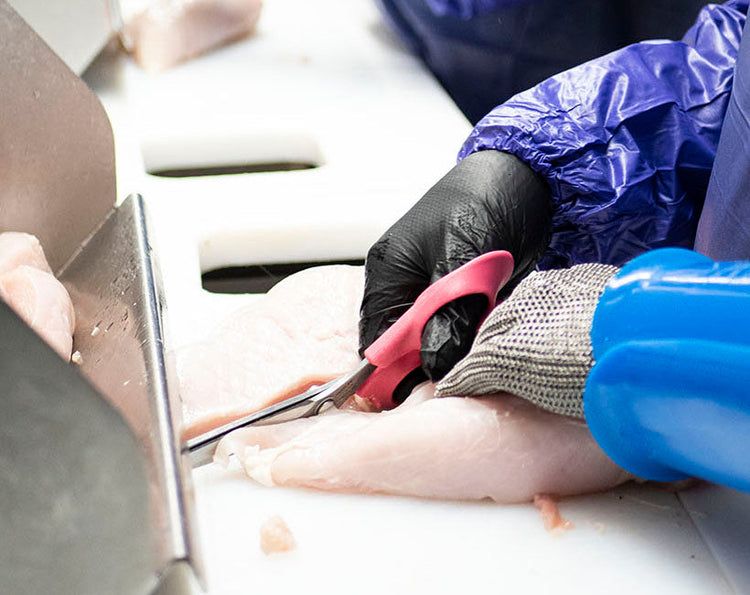DanielDull poultry processing shears do more than slow down your operation and leave valuable meat on the bone. Studies show workers using dull shears in poultry processing suffer high levels of repetitive motion injuries and other preventable ailments.
Let’s take a closer look at how using poorly sharpened or dull shears in poultry processing can hurt both your people and your bottom line.
Repetitive Motion Injuries: The Hidden Cost of Dull Shears
We all know poultry processing is tough on people and equipment, but while dull edges can be sharpened and knives and scissors can be replaced, an injury to a trained, experienced worker can have an outside impact on your business and an employee’s life.
A busy poultry processing line can make up to 25,000 cuts a day processing chickens and turkeys. While the poultry industry has made great progress in reducing overall occupational illnesses in recent years, chronic repetitive motion or injuries from working continuously with poor quality or inappropriate equipment remain a particular problem.
What are Repetitive Motion Injuries?
Repetitive Motion Injuries (RMI) refer to chronic injuries or disorders to muscles, tendons, and bones as the result of trauma from repeated use or overexertion. These injuries can significantly affect the upper arms, forearms, and hands.
Common forms of RMI include:
- Muscle strains
- Tendinitis
- Epicondylitis
- Trigger finger
- Carpal tunnel syndrome
RMI are cumulative injuries resulting from strained or swollen muscles or irritated tissues, or from trauma like repeated small muscle tears or tendons rubbing against bone. That means early detection is essential to preventing and minimizing their impact.
Left untreated, injuries like carpal tunnel syndrome can be debilitating, preventing a sufferer from being able to perform work or many other functions of everyday life.
Why RMI Is a Problem in the Poultry Industry
Workers in the poultry industry are particularly at risk of RMI and other preventative cumulative injuries. A review of studies by the federal Government Accountability Office (GAO) found that despite improvements in recent years, occupational injuries occur at a far higher rate in the meat and processing industry than in the wider U.S. manufacturing sector.
Researchers believe the combination of high line speeds and the fine motor skills needed to process birds put poultry workers’ wrists and hands at particular risk of RMI injuries, while the cold condition in temperature-controlled plants also made muscle injuries more likely.
The GAO review cited a National Institute for Occupational Safety and Health (NIOSH) of a poultry plant in Maryland that found that roughly a third of workers at the plant reported symptoms meeting the institute’s definition for carpal tunnel syndrome. A similar study of a plant in South Carolina found that 42% of study participants exhibited carpal tunnel symptoms.
Meanwhile, a study published by the American Industrial Hygiene Association linking workers' health records to their work methods and postures recommended both improved work procedures and better-designed cutting tools to reduce chronic injuries.
How Can RMI Affect Your Business?
RMI and related ailments can have a debilitating effect on the workers on which your business depends. Finding skilled workers is difficult, particularly in today’s labor market, and losing just one or two workers a day can quickly result in a measurable loss in production. You will also likely face further knock on costs, including:
- More overtime for your existing team
- Higher training and hiring costs for additional workers
- A greater risk of lost-time accidents
Your company might face:
- Increased claims for workers’ compensation
- Higher health insurance costs as more workers require expensive surgeries
While hard to measure objectively, worries about becoming injured or about worsening RMI symptoms also have the potential to zap worker morale, lowering performance across your value chain.
How Can You Prevent RMI in Your Plant?
Federal and state regulators have made specific suggestions about how to improve safety and reduce RMI in poultry and meat processing plants.
These include:
- Using cutting tools specifically designed for the task
- Using the right size cutting tool for a worker’s hand
- Using customized or specially designed tools with angled blades designed to keep hands in a neutral position
- Putting in place a specific sharpening program to make sure sharp knives are always available
As a manager, taking relatively small and simple steps to prevent RMI in your operation can have an outsized effect on the productivity — and profitability of your plant:
- Choose high-quality poultry shears designed specifically for your plant’s process
- Install the best sharpening equipment and ensure dull shears are sharpened immediately by properly trained staff
Stay Sharp, Pick Wolff
When worker health and safety and plant productivity are a priority, Wolff Industries’ specialty sharpening equipment and shears provide unbeatable quality and long-term value.
Wolff offers our own U.S.-made shears and premium KAI scissors, both designed specifically for poultry processing and featuring:
- Durable hardened food-grade stainless steel
- Chemically-bonded “soft but strong” handles
- Traceable barcoding and serial numbers
- Full compatibility with our Wolff Trax tracking system
- Expert hand sharpening of every blade we deliver
Our dedicated customer support team is also always available to help you with custom blunted or curved blades, left-handed scissors, and size matching.
Choose Wolff for speed, safety, and yield. Click below to learn more about our specialty poultry processing shears.


